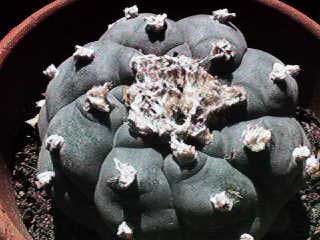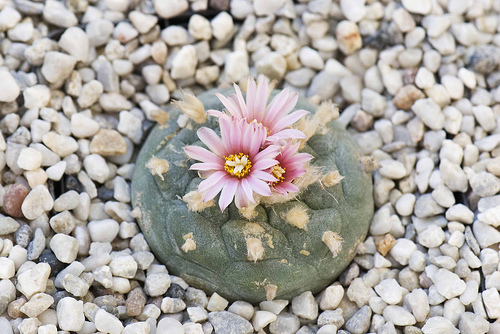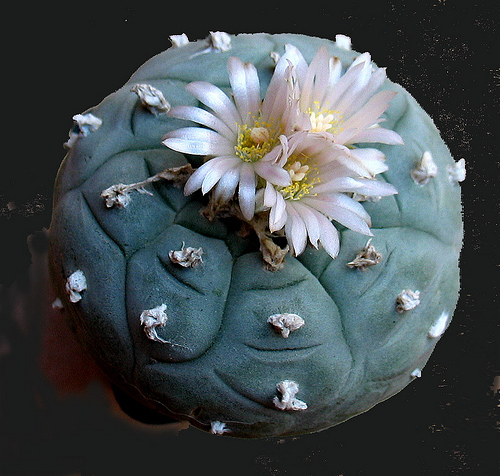Classification
Domain:Eukarya
Kingdom:Plantae
Phylum:Magnoliophyta
Class:Magnoliopsida
Order:Caryophyllales
Family:Cactaceae
Genus:Lophophora
Species:Lophophora williamsii
Common names: Peyote, Sacred Cactus, Buttons, Mescalito
Classifying organisms can
be an extensive and complicated process. However, it
is very important to classify organisms for many
reasons. Classification groups new organisms with
already identified ones. It also provides means of
communication and comparison between organisms.
Below I provided explanations, to give you a better
understanding as to why Peyote fits into each
particular classification.
Domain:Eukarya-
The latin word “Eukaryote” translates
to “true nucleus.” This is the distinguishing factor
that separates them from prokaryotes. All members of
the domain Eukarya contain membrane bound organelles
such as chloroplasts and mitochondria.

Phylum:Magnoliophyta- Organisms in this phylum include plants with a vascular system and specialized transport systems. These organisms have roots, stems, and leaves. They are considered to be angiosperms, otherwise known as flowering plants. Some other organisms that fit this phylum are calla lilies, sweet orange, and the Oregon Grape.
Class:Magnoliopsida-
This class consists of around 170,000 species of
angiosperms including Peyote. An angiosperm can be
defined as a seed producing plant , where seeds are
enclosed in protective ovaries. Organisms in this
class are commonly referred to as dicotyledons- (dicots)
although dicots are not a recognized phylogenetic
group.
Order:Caryophyllales– Organisms in this
particular order are flowering plants considered to
be core
eudicots. Compared
to species in other orders, Caryophyllales are
structurally or physiologically
adapted to more to extreme environments. Examples of
these habitats include deserts, high-alkaline soils,
high-saline substrates, and nutrient-poor soils.
Family:Cactaceae-
Members of the Cactaceae
family have adapted to survive in hot and dry
climate zones. These adaptations
include an evolved stem and leaves. The
stem has evolved to be able to
photosynthesize
while the leaves have evolved into spines. In
addition members of the Cactaceae
family are considered to be
succulent plants.
Genus:Lophophora- The name 'Lophophora' comes from the Greek translation meaning 'crest bearer’. This crest is referring to the tufts of hair that can be seen on the the tubercles of some members of this particular genus. There are only two official species belonging to this genus.
Species:Lophophora williamsii: Lophophora williamsii is a small grey/green spineless cactus which produces pink flowers. Members of this species contain a large spectrum of phenethylamine alkaloids, including mescaline classifying it as a hallucinogen.
To get a bigger picture
Lophophora williamsii fits in
relation to other plants view this
phylogenetic tree.
When looking at this tree, based on morphological
features, remember that peyote fits into the
Caryophyllales order.
Now that you know how to classify peyote, you may want to learn about it's habitat. Otherwise you may go back to the homepage and investigate on your own.
Your content goes here.


